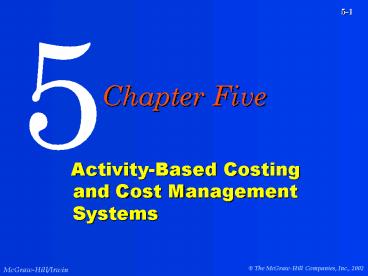ActivityBased Costing and Cost Management Systems - PowerPoint PPT Presentation
1 / 20
Title:
ActivityBased Costing and Cost Management Systems
Description:
McGraw-Hill/Irwin. 5-7. Unit Level Done for each unit of production ... Lost faith in cost reports. Direct labour is a small percentage of total product costs. ... – PowerPoint PPT presentation
Number of Views:93
Avg rating:3.0/5.0
Title: ActivityBased Costing and Cost Management Systems
1
5
Chapter Five
- Activity-Based Costing and Cost Management
Systems
2
- Job-order costing
- Costs accumulated by the job.
- Work in process has a job-cost sheet for each
job. - Many unique, high cost jobs.
- Jobs built to customer order.
- Process costing
- Costs accumulated by department or process.
- Work in process has a production report for each
batch of products. - A few identical, low cost products.
- Units continuously produced for inventory in
automated process.
3
Traditional, Volume-Based Product-Costing System
- Job-order costing and process costing are
traditional, volume-based product-costing systems - A volume-based costing system assigns costs to
products on the basis of a single activity base
related to volume - Often uses a single plantwide overhead rate based
on one volume-related cost driver - Also called a throughput-based costing system
4
Problems with the traditional, volume-based
costing approach
- Manufacturing processes have become more highly
automated technological innovation - Computer-integrated manufacturing (CIM) most of
the work accomplished by machines - Increasing competition both at home and abroad
RESULT MORE ELABOARTE COSTING SYSTEMS
5
Activity Based Costing System
ABC
- ABC systems follow a two-stage procedure to
assign overhead costs to products.
Assigning overhead to products is a difficult
(but fun) process.
I agree!
6
Activity Based Costing System
ABC
- ABC systems follow a two-stage procedure to
assign overhead costs to products.
Lets begin by identifying our major activities.
Stage OneIdentify significant activities and
assign overhead costs to each activity
in proportion to resources used.
7
Stage 1 - Major activities
ABC
- Unit Level Done for each unit of production
- Batch Level Performed for each batch of
products rather than each unit - Product-sustaining Done to support an entire
product line but not always performed every time
a new unit or batch is produced - Facility Required in order for the entire
production process to occur
8
Activity Based Costing System
ABC
- Lets look at exercise 5-32
- Trimming
- Tying
- Hilling
- Conditioning
- Untying
- Chemical spraying
- Harvesting
- Stemming crushing
- Pressing
- Filtering
- Fermentation
Classify each of the activities as a unit, batch
product-sustaining or facility-level activity
- Aging
- Trimming
- Labeling
- Packing
- Case labeling
- Shipping
- Maintenance on buildings
- 19. Maintenance on equipment
Sure!
9
Activity Based Costing System
ABC
- ABC systems follow a two-stage procedure to
assign overhead costs to products.
Overhead assigned to activities are called
activity cost pools.
Stage TwoIdentify cost drivers appropriate to
each activity and allocate overhead to the
products.
10
Cost Drivers
- A characteristic of an event or activity that
results in the incurrence of costs. In selecting
a cost driver, we must consider . . .
Degree of Correlation
Behavioral Effects
Cost of Measurement
11
Activity Based Costing System
ABC
12
THE KEY Direct versus Indirect Costs
ABC
- Volume-Based Costing
- All production costs except direct materials and
direct labour are lumped together in one overhead
cost pool.
- Activity-Based Costing
- An effort is made to account for as many costs
as possible as direct costs of production.
13
Peterson, Inc.Problem 5-36 pg 207
14
Product Cost Distortion
- Can you identify any problems Peterson is likely
to face as a result of this distortion?
24 x 3000 units
18 x 4000 units
15
Product Cost Distortion Why?
- A large proportion of nonunit- level activities
A unit-level cost driver will not be able to
assign the costs of nonunit level activities
accurately. - Product diversity When consumption ratios
differ widely between activities, no single cost
driver will accurately assign the resulting
overhead.
16
Some KEY Issues
ABC
- Remember that DM DL are the same under
traditional, volume-based costing and ABC. The
difference is in the assignment of overhead. - ABC attempts to account for as many costs as
possible as direct costs of production. - Why does traditional, volume-based costing
distort product costs? - Why has there been a movement towards
ABC?
17
Some KEY Issues - cont
ABC
- ABC requires that the most significant cost
drivers are identified. Consider the degree of
correlation between the activity and the driver,
the cost/benefit and behavioral effects of
choosing a particular driver. - Also consider the homogeneity of each activity
potential cost pool. - Rather than a pool rate (cost per unit of the
cost driver), costs may sometimes be assigned to
products using transaction based costing.
18
When ?
ABC
- Product-line profit margins are hard to explain.
- Sales are increasing but profits are declining.
- Lost faith in cost reports.
- Direct labour is a small percentage of total
product costs. - Some products that have reported high profit
margins are not sold by competitors. - Overhead rates are very high and increasing over
time.
- Once again, a cost/benefit decision.
19
in the Service Industry
ABC
- ABC also applicable in service industries
objectives are the same. - Activities tend to be repetitive human tasks.
- High proportion of facility-level costs.
Implementation Problems
20
End of Chapter 5

